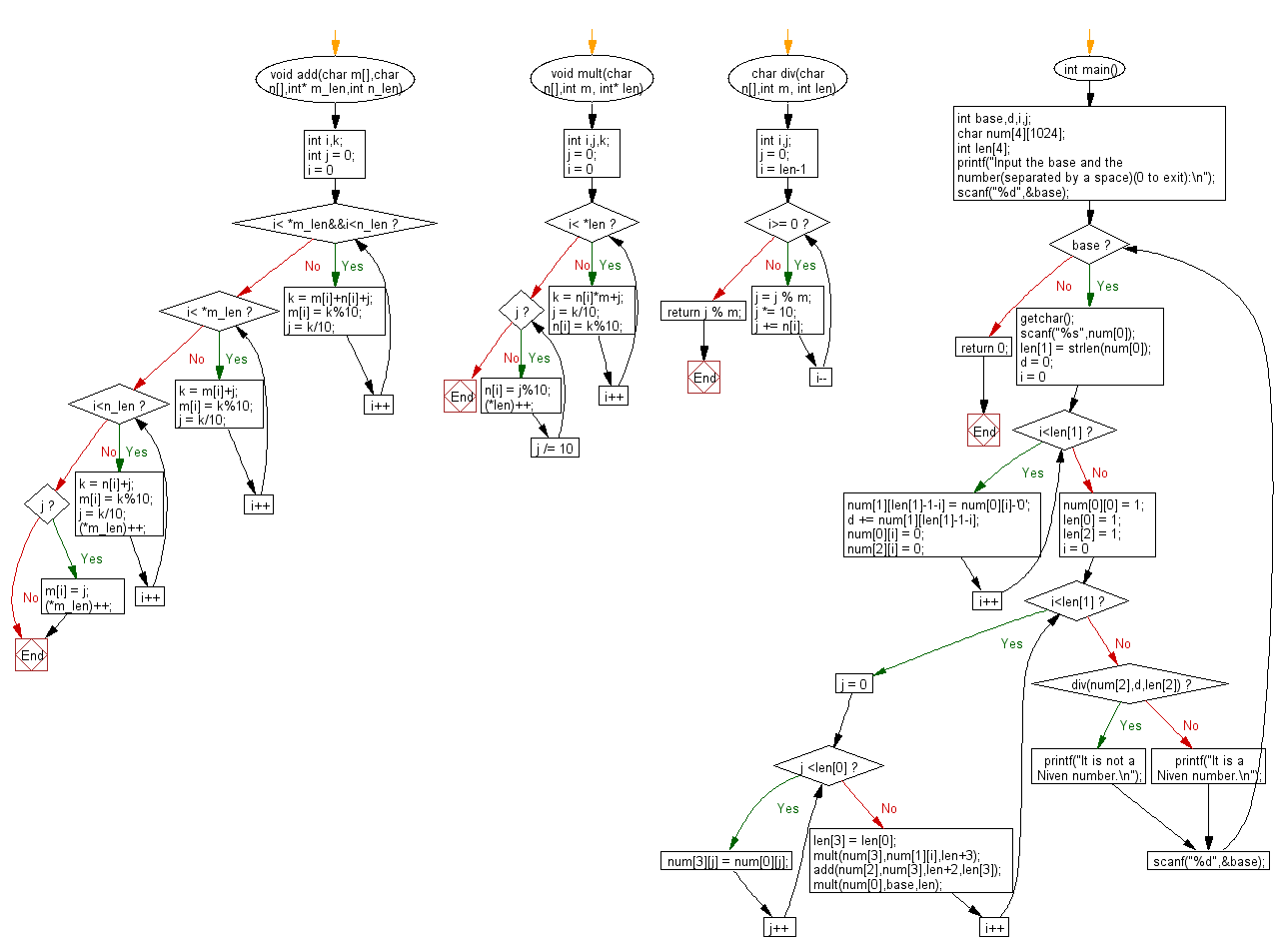C Exercises: Check whether a given number with base b is a Niven number or not
C Numbers: Exercise-38 with Solution
Write a C programming to check whether a given number with base b (2 <= b<= 10) is a Niven number or not.
From Wikipedia,
In recreational mathematics, a harshad number (or Niven number) in a given number base, is an integer that is divisible by the sum of its digits when written in that base. Harshad numbers in base n are also known as n-harshad (or n-Niven) numbers. Harshad numbers were defined by D. R. Kaprekar, a mathematician from India. The word "harshad" comes from the Sanskrit harṣa (joy) + da (give), meaning joy-giver. The term “Niven number” arose from a paper delivered by Ivan M. Niven at a conference on number theory in 1977. All integers between zero and n are n-harshad numbers.
The number 18 is a harshad number in base 10, because the sum of the digits 1 and 8 is 9 (1 + 8 = 9), and 18 is divisible by 9 (since 18/9 = 2, and 2 is a whole number).
Test Data
Input: base 10: Number 3
Output: 3 is a Niven Number
Input: base 10: Number 18
Output: 18 is a Niven Number
Input: base 10: Number 15
Output: 15 is not a Niven Number
Sample Solution:
C Code:
#include <stdio.h>
#include <string.h>
void add(char m[],char n[],int* m_len,int n_len)
{
int i,k;
int j = 0;
for(i = 0; i< *m_len&&i<n_len; i++)
{
k = m[i]+n[i]+j;
m[i] = k%10;
j = k/10;
}
for(;i< *m_len; i++)
{
k = m[i]+j;
m[i] = k%10;
j = k/10;
}
for(;i<n_len; i++)
{
k = n[i]+j;
m[i] = k%10;
j = k/10;
(*m_len)++;
}
if(j)
{
m[i] = j;
(*m_len)++;
}
}
void mult(char n[],int m, int* len)
{
int i,j,k;
j = 0;
for(i = 0; i< *len; i++)
{
k = n[i]*m+j;
j = k/10;
n[i] = k%10;
}
for(;j;j /= 10)
{
n[i] = j%10;
(*len)++;
}
}
char div(char n[],int m, int len)
{
int i,j;
j = 0;
for(i = len-1; i>= 0; i--)
{
j = j % m;
j *= 10;
j += n[i];
}
return j % m;
}
int main()
{
int base,d,i,j;
char num[4][1024];
int len[4];
printf("Input the base and the number(separated by a space)(0 to exit):\n");
scanf("%d",&base);
while(base)
{
getchar();
scanf("%s",num[0]);
len[1] = strlen(num[0]);
d = 0;
for(i = 0; i<len[1]; i++)
{
num[1][len[1]-1-i] = num[0][i]-'0';
d += num[1][len[1]-1-i];
num[0][i] = 0;
num[2][i] = 0;
}
num[0][0] = 1;
len[0] = 1;
len[2] = 1;
for(i = 0; i<len[1]; i++)
{
for(j = 0; j <len[0]; j++)
{
num[3][j] = num[0][j];
}
len[3] = len[0];
mult(num[3],num[1][i],len+3);
add(num[2],num[3],len+2,len[3]);
mult(num[0],base,len);
}
if(div(num[2],d,len[2]))
{
printf("It is not a Niven number.\n");
}
else
printf("It is a Niven number.\n");
scanf("%d",&base);
}
return 0;
}
Sample Output:
Input the base and the number(separated by a space)(0 to exit): 10 3 0 It is a Niven number.
Flowchart:

C Programming Code Editor:
Contribute your code and comments through Disqus.
Previous: Write a program in C to check if a number is Keith or not(with explanation).
Next: C String Exercises Home
What is the difficulty level of this exercise?
Test your Programming skills with w3resource's quiz.
C Programming: Tips of the Day
Static variable inside of a function in C
The scope of variable is where the variable name can be seen. Here, x is visible only inside function foo().
The lifetime of a variable is the period over which it exists. If x were defined without the keyword static, the lifetime would be from the entry into foo() to the return from foo(); so it would be re-initialized to 5 on every call.
The keyword static acts to extend the lifetime of a variable to the lifetime of the programme; e.g. initialization occurs once and once only and then the variable retains its value - whatever it has come to be - over all future calls to foo().
Ref : https://bit.ly/3fOq7XP
- New Content published on w3resource:
- HTML-CSS Practical: Exercises, Practice, Solution
- Java Regular Expression: Exercises, Practice, Solution
- Scala Programming Exercises, Practice, Solution
- Python Itertools exercises
- Python Numpy exercises
- Python GeoPy Package exercises
- Python Pandas exercises
- Python nltk exercises
- Python BeautifulSoup exercises
- Form Template
- Composer - PHP Package Manager
- PHPUnit - PHP Testing
- Laravel - PHP Framework
- Angular - JavaScript Framework
- Vue - JavaScript Framework
- Jest - JavaScript Testing Framework
